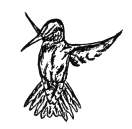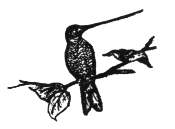

Hummingbird
Hummingbirds are the smallest things in feathers, and the prettiest. They have been called feathered prisms, living rainbows.
The giant hummingbird of the Andes mountains may be 6 or 8 inches long. The bee hummingbird of Cuba is about 2 inches long and half of that is bill and tail. The ruby throat, the most common in North America, is 3 1/2 to 3 3/4 inches long.
Hummingbirds are special, not only because of their size, but because of what they can do. They are the only birds that can hover in the air, holding their bodies perfectly still. (The first helicopters!) They are almost the only birds that can fly backward. They can also fly upside down. They can make sharp turns in the air and dart in any direction. With its needle-sharp bill for a weapon, a hummingbird is more than a match for any larger bird that would want to attack it.
Fascinating Facts About Birds
by Mina Arnold Young
|
Most hummingbirds show off when seeking a mate. One, the plack-chinned, flies in half circles above the female he is trying to impress. At the top of each swoop he stops dead still and touches his wings together under his body.
A hummingbird has to fly if it wants to move an inch. Its feet are only strong enough for perching. When it takes off it doesn't spring into the air like most birds do. A moving picture of one taking off from a thin twig showed the twig rising before the bird let go.
A hummingbird has a larger heart for its size than any other bird, and larger flight muscles. Such a big motor needs a lot of fuel, so a hummingbird has to eat 50 or 60 meals a day. If a hummingbird and a chicken were the same weight the hummingbird would use 25 times as much energy as the chicken. It would starve to death overnight if its body did not slow down and its temperature drop several degrees.
 Yet the ruby throat hummingbird flies to South America in the fall and back in the spring, 500 miles non-stop across the Gulf of Mexico! Before it leaves it builds up a layer of fat under its skin equal to half its body weight. But that is only a fraction of an ounce! No one but God knows how these tiny birds can fly so far on so little fuel.
Yet the ruby throat hummingbird flies to South America in the fall and back in the spring, 500 miles non-stop across the Gulf of Mexico! Before it leaves it builds up a layer of fat under its skin equal to half its body weight. But that is only a fraction of an ounce! No one but God knows how these tiny birds can fly so far on so little fuel.
There are many varieties of hummingbirds most of them living in Central and South America. They come in beautiful colors and many shapes. One variety has a bill longer than its body. Some have long tails that trail out behind them as they fly.
Hummingbirds live mainly on nectar from flowers, but they also eat little insects that they find there. Their long bills can reach into most flowers. The tongue can run out beyond the bill and go around curves. It has a brushy tip which helps in gathering insects and spiders. Sometimes it brushes pollen from one flower and carries it to the next. Some plants are pollinated entirely by them.
Toucan
|
Index
|
Home
 Yet the ruby throat hummingbird flies to South America in the fall and back in the spring, 500 miles non-stop across the Gulf of Mexico! Before it leaves it builds up a layer of fat under its skin equal to half its body weight. But that is only a fraction of an ounce! No one but God knows how these tiny birds can fly so far on so little fuel.
Yet the ruby throat hummingbird flies to South America in the fall and back in the spring, 500 miles non-stop across the Gulf of Mexico! Before it leaves it builds up a layer of fat under its skin equal to half its body weight. But that is only a fraction of an ounce! No one but God knows how these tiny birds can fly so far on so little fuel.
